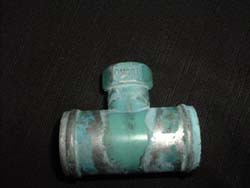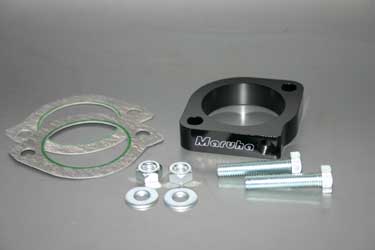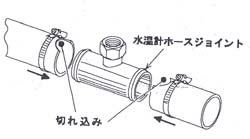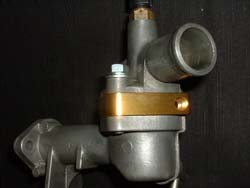
| ITEM | UNIT |
| Water temperature sensor adapter | 1 |
| Adapter gasket | 2 |
| Long bolt | 2 |
| Nut | 2 |
| Washer | 2 |

(Photo 1) The full contents of Maruha Aluminum Adapter's kit
Clockwise: Water temperature sensor adapter, 2 long bolts, 2 nuts, 2 washers and 2 adapter gaskets
* The adapter in black is available now.
The former gold model that's sales ended is pictured on this web page owing to circumstances.
When you install a water temperature sensor in your car, one of the popular ways of fixing is sealing a T-joint between the radiator hoses (Photo 2).
However, there are many disadvantages.
Picture 1 shows how to connect a joint between radiator hoses.
The metal joint with 10 cm and more length forces the hoses to reduce their flexibility, as the rubber hoses are too short.

(Photo 2) T-joint for connecting radiator hoses

(Picture 1) Connecting a joint between radiator hoses
to maintain its stretch.
Moreover, it needs to detach the whole sensor system whenever a radiator hose is replaced with a new one.
A sensor end of a water temperature gauge is large enough to have a chance of interrupting the coolant flow throughout the T-joint.
Maruha fortunately found a way to install a sensor without cutting the radiator hose by means of providing an adapter between the thermostat housing pipes (Photo 3).

(Photo 3) Maruha Aluminum Adapter sandwiched between the NA6CE thermostat housing pipes
The adapter allows the water temperature sensor to be installed without having to divide hoses.
If you are planning to use Maruha 78 Thermostat, a thicker adapter 78 Thermostat& WaterTemp Sensor Adapter Kit for NA6CE is available.
Our water temperature adapter for NA6CE with alumite surface treatment has the anti corrosion against the coolant fluid that the adapter is always exposed to.
The adapter helps the MIATA genuine thermostat to be fixed in the thermohousing with no interference of the water flow.
The product for NA6CE is suitable for electric water temperature sensors with 1/8 PT(Not for 1/8NPT) threads.
Water temperature gauges are mainly divided into mechanical and electric ones.
A mechanical water temperature gauge displays the temperature with a thermometer in the radiator.
The mechanical gauge is free from electric system failure such as connection failure and bad insulation because the gauge needs no power to operate except the minimum wiring for the meter display.
The gauge has also weak points.
The system is fully assembled.
It means that the coolant system needs to be broken in to remove the sensor when the gauge is replaced.
In addition to this, the thermosensor is sufficiently large to disturb the coolant circulating.
An electric water temperature gauge has a smaller sensor.
The gauge is easier to be replaced than a mechanical one, as the system is wired to be detached separately.
However, there is a possibility of electric failures and sensor damages due to the sensor system controlled with electric signals.
Though both of the models have advantages and disadvantages, Maruha used to recommend mechanical gauges to our customers because they were safe from electric damages.
Electric meters on the contrary, had many disadvantages including bad performance of the gauges and the reasons made us avoid using them.
Amp temperature gauges, however, have been recently recommended for the simple wiring and the complete functions.
Actually, the amp gauges that Maruha has adopted have had no errors.
Below, we explain how to install Maruha Aluminum Adapter.
[How to Install the Product for NA8C and MB Models] * In case of mounting to NA6 models, see 78 Thermostat& WaterTemp Sensor Adapter Kit for NA6CE page.
Tighten the stud bolt and the kit nuts (Photo 4).
(Photo 4) Use a torque wrench to tighten the nuts inside the thermostat housing. Remove the stud bolt (Photo 5).
(Photo 5)
Remove the old gasket from the thermostat housing.
Smooth the surface of the housing (Photo 6).
Oilstones help you to work effectively (Photo 7).
(Photo 6) (Photo 7)
Install the accessories in the right order as follows.
Install the thermostat in the housing.
Place one of the kit gaskets onto the thermostat.
Put the kit adapter on the gasket.
Lay the other gasket on the adapter.
Assemble the thermostat housing with the kit long bolts (Photo 8).
(Photo 8) * Pay attention not to damage the screw head when removing the stud bolt from the thermostat housing.
[NOTE]
The product must be installed by a professional.
[Home]